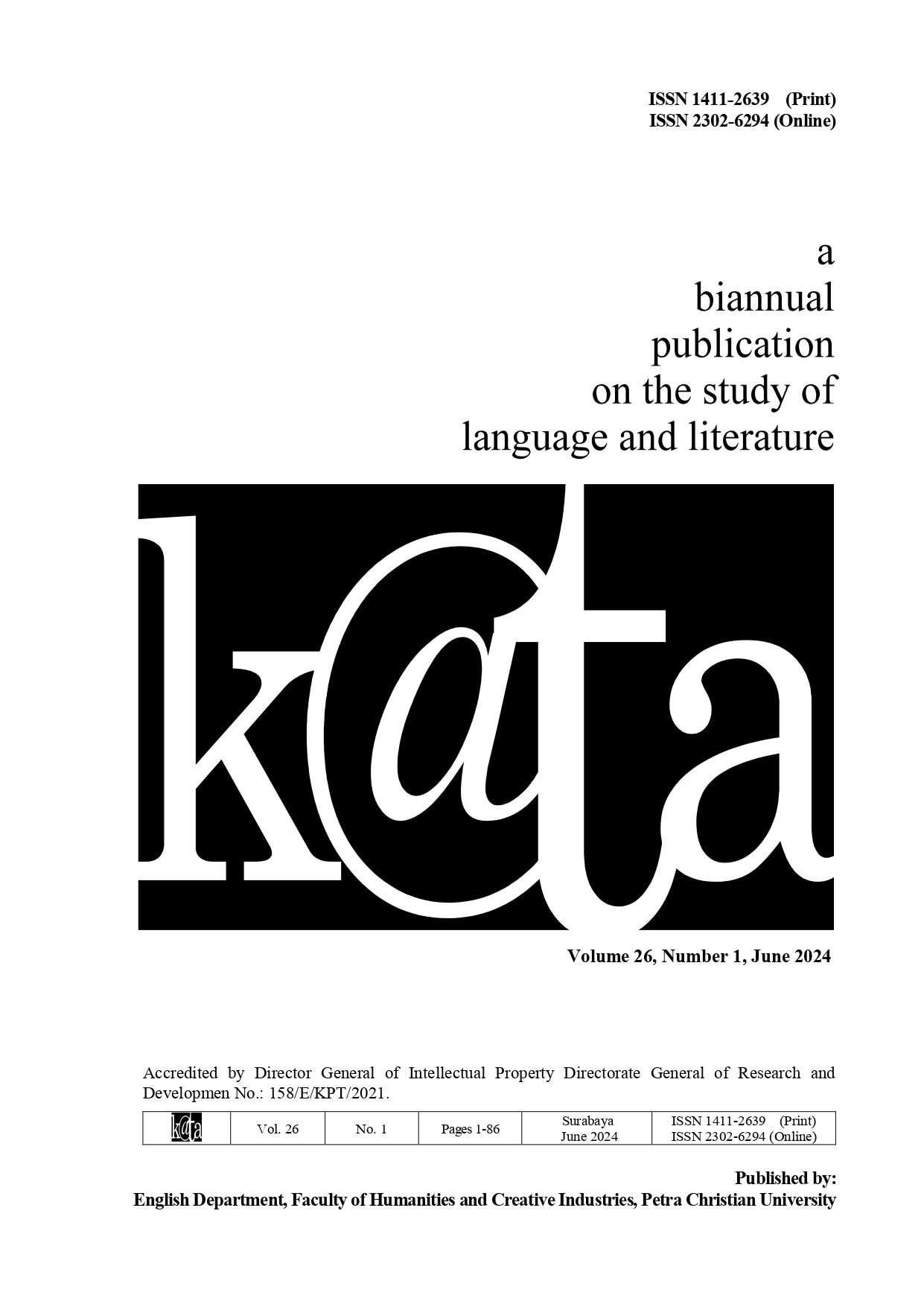Metacinema as Diasporic Postmemory in Justin Chon’s Blue Bayou (2021)
DOI:
https://doi.org/10.9744/kata.26.1.1-13Keywords:
Blue Bayou, Postmemory, Identity, MetacinemaAbstract
Blue Bayou (2021), a film by Justin Chon, presents issues of imagination, postmemory, and identity through self-referential techniques. Referring to Marianne Hirsch’s theory on postmemory, this article examines how this film represents imagined moments and how they serve as a postmemory of the history of Korean immigrants, and how this kind of forgetting constitutes the American shared experience. The findings and discussion show that imagined moments in Antonio's subconscious function as postmemory for Antonio, while the film itself serves as a postmemory for America’s imagination. It can be argued that Blue Bayou deliberately acknowledges itself as a film and as fiction to present the world that America imagines and understands. We argue that Blue Bayou conceives memory, fosters imagination, and acts as a documentation for the audience as well as for America’s fragmented memory.
Downloads
References
Candidatu, L. (2021). Diasporic mothering and Somali diaspora formation in the Netherlands. Journal of Global Diaspora & Media, 2(1), 39–55. https://doi.org/10.1386/gdm_00013_1
Chon, J. (Director). (2017). Gook [Film]. Datari Turner Productions; Birthday Soup Films; Foxtrout Studios; The Fishbowl Studios; Tunnel Post.
Chon, J. (Director). (2019). Ms. Purple [Film]. Electric Panda Entertainment; MACRO; Plan Zero Productions.
Chon, J. (Director). (2021). Blue bayou [Film]. Focus Features; Entertainment One; MACRO.
Chu, J. M. (Director). (2018). Crazy rich Asians [Film]. Ivanhoe Pictures; Color Force; Sidney Kimmel Entertainment.
Chu, S.-Y. (2008). Science fiction and postmemory han in the contemporary Korean American literature. MELUS: Multi-Ethnic Literature of the United States, 33(4), 97–121. https://doi.org/10.1093/melus/33.4.97
Felman, S. (2021). Shoah: Art as visualizing what cannot be grasped. In D. LaRocca (Ed.), Metacinema: The form and content of filmic reference and reflexivity (pp. 233-252). Oxford University Press. https://doi.org/10.1093/oso/9780190095345.003.0012
Graham, S. (2019). A history of the bildungsroman. Cambridge University Press. https://doi.org/10.1017/9781316479926
Harris, T. (2009). ‘The yellow rose of Texas’: A different cultural view. Callaloo, 32(2), 529–539. https://doi.org/10.1353/cal.0.0434
Hirsch, M. (1993). Family pictures: Maus, mourning, and postmemory. Discourse – Journal for Theoretical Studies in Media and Culture, 15(2), 3–29. http://www.jstor.org/stable/41389264
Hirsch, M. (1996). Past Lives: Postmemories in exile. Poetics Today, 17(4), 659. https://doi.org/10.2307/1773218
Hirsch, M. (2001). Surviving images: Holocaust photographs and the work of Postmemory. The Yale Journal of Criticism, 14(1), 5–37. https://doi.org/10.1353/yale.2001.0008
Holl, U. (2017). Cinema, trance and cybernetics. Amsterdam University Press eBooks. https://doi.org/10.5117/9789089646682
Kim, M. M. (2023). The measure of Han [Unpublished master’s thesis]. OCAD University. https://openresearch.ocadu.ca/id/eprint/4127
Laybourn, W. M. (2018). Being a transnational Korean adoptee, becoming Asian American. Contexts, 17(4), 30–35. https://doi.org/10.1177/1536504218812866
Nelson, P. K. (2009). Mapping multiple histories of Korean American transnational adoption. US-Korea Institute at SAIS. http://www.jstor.org/stable/resrep11130
Oksman, T. (2020). Postmemory and the “fragments of a history we cannot take in”. WSQ: Women’s Studies Quarterly, 48(1–2), 133–136. https://doi.org/10.1353/wsq.2020.0027
Palis, E. (2021). Méliès, Astruc, and Scorsese: Authorship, historiography, and videographic styles. In D. LaRocca (Ed.), Metacinema: The form and content of filmic reference and reflexivity (p. 115). Oxford University Press.
Pence, J. C. (2018). Postcinema/postmemory. In P. Grainge (Ed.), Memory and popular film (pp. 237-256). Manchester University Press. https://doi.org/10.7765/9781526137531.00020
Prince, S. (2004). The emergence of filmic artifacts: Cinema and cinematography in the digital era. Film Quarterly, 57(3), 24–33. https://doi.org/10.1525/fq.2004.57.3.24
Scorsese, M. (2011). Hugo. GK Films; Infinitum Nihil; Janimation; Paramount Pictures.
Setka, S. (2015). Bastardized history: How inglourious basterds breaks through American screen memory. Jewish Film & New Media, 3(2), 141. https://doi.org/10.13110/jewifilmnewmedi.3.2.0141
Shibolet, Y. (2021). Waltz with Bashir’s Animated Traces: Troubled indexicality in contemporary documentary rhetorics. In D. LaRocca (Ed.), Metacinema: The form and content of filmic reference and reflexivity (pp. 271–290). Oxford University Press. https://doi.org/10.1093/oso/9780190095345.003.0014
Siska, W. C. (1979). Metacinema: A modern necessity. Literature/Film Quarterly, 7(4), 285–289.
Sohn, S. H. (2020). Toward Korean American ethnoformalisms: The historian-archivist and speculative gendered empowerments in Minsoo Kang’s of tales and enigmas. Journal of the Fantastic in the Arts, 31, 2(108), 223–245.
Downloads
Published
How to Cite
Issue
Section
License
![]() This work is licensed under a Creative Commons Attribution License
This work is licensed under a Creative Commons Attribution License



.png)
.png)

















